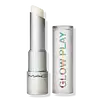What's inside
What's inside
 Key Ingredients
Key Ingredients

 Benefits
Benefits

 Concerns
Concerns

 Ingredients Side-by-side
Ingredients Side-by-side

Diisostearyl Malate
EmollientHydrogenated Polyisobutene
EmollientVp/Hexadecene Copolymer
Octyldodecyl Stearoyl Stearate
EmollientPolyethylene
AbrasivePentaerythrityl Tetraisostearate
EmollientOzokerite
Emulsion StabilisingSimmondsia Chinensis Seed Oil
EmollientMangifera Indica Seed Butter
Skin ConditioningButyrospermum Parkii Butter
Skin ConditioningCaprylic/Capric Triglyceride
MaskingDiethylhexyl Syringylidenemalonate
Skin ProtectingTin Oxide
AbrasiveSynthetic Fluorphlogopite
Citric Acid
BufferingAroma
Mica
Cosmetic ColorantCI 77891
Cosmetic ColorantCI 77491
Cosmetic ColorantCI 77492
Cosmetic ColorantCI 77499
Cosmetic ColorantCI 77163
Cosmetic ColorantCI 42090
Cosmetic ColorantCI 77400
Cosmetic ColorantCI 75470
Cosmetic ColorantCI 77742
Cosmetic ColorantCI 15850
Cosmetic ColorantCI 45380
Cosmetic ColorantCI 45410
Cosmetic ColorantCI 73360
Cosmetic ColorantCI 17200
Cosmetic ColorantCI 19140
Cosmetic ColorantCI 15985
Cosmetic ColorantDiisostearyl Malate, Hydrogenated Polyisobutene, Vp/Hexadecene Copolymer, Octyldodecyl Stearoyl Stearate, Polyethylene, Pentaerythrityl Tetraisostearate, Ozokerite, Simmondsia Chinensis Seed Oil, Mangifera Indica Seed Butter, Butyrospermum Parkii Butter, Caprylic/Capric Triglyceride, Diethylhexyl Syringylidenemalonate, Tin Oxide, Synthetic Fluorphlogopite, Citric Acid, Aroma, Mica, CI 77891, CI 77491, CI 77492, CI 77499, CI 77163, CI 42090, CI 77400, CI 75470, CI 77742, CI 15850, CI 45380, CI 45410, CI 73360, CI 17200, CI 19140, CI 15985
Water
Skin ConditioningAloe Barbadensis Leaf Juice
Skin ConditioningCetearyl Alcohol
EmollientGlycerin
HumectantBehentrimonium Methosulfate
Stearalkonium Chloride
PreservativeButyrospermum Parkii Butter
Skin ConditioningHoney
HumectantCitric Acid
BufferingSodium Levulinate
Skin ConditioningPotassium Sorbate
PreservativeCocos Nucifera Oil
MaskingPrunus Armeniaca Kernel Oil
MaskingColloidal Oatmeal
AbsorbentGuar Hydroxypropyltrimonium Chloride
Skin ConditioningSodium Gluconate
Skin ConditioningTocopherol
AntioxidantVaccinium Macrocarpon Seed Oil
Skin ConditioningSwertia Japonica Extract
Skin ConditioningStearyl Alcohol
EmollientThiamine Hcl
MaskingLeuconostoc/Radish Root Ferment Filtrate
AntimicrobialWater, Aloe Barbadensis Leaf Juice, Cetearyl Alcohol, Glycerin, Behentrimonium Methosulfate, Stearalkonium Chloride, Butyrospermum Parkii Butter, Honey, Citric Acid, Sodium Levulinate, Potassium Sorbate, Cocos Nucifera Oil, Prunus Armeniaca Kernel Oil, Colloidal Oatmeal, Guar Hydroxypropyltrimonium Chloride, Sodium Gluconate, Tocopherol, Vaccinium Macrocarpon Seed Oil, Swertia Japonica Extract, Stearyl Alcohol, Thiamine Hcl, Leuconostoc/Radish Root Ferment Filtrate
Ingredients Explained
These ingredients are found in both products.
Ingredients higher up in an ingredient list are typically present in a larger amount.
This ingredient is also known as shea butter. It is an effective skin hydrator and emollient.
Emollients help soothe and soften your skin. It does this by creating a protective film on your skin. This barrier helps trap moisture and keeps your skin hydrated. Emollients may be effective at treating dry or itchy skin.
Shea butter is rich in antioxidants. Antioxidants help fight free-radicals, or molecules that may harm the body. It is also full of fatty acids including stearic acid and linoleic acid. These acids help replenish the skin and keep skin moisturized.
While Shea Butter has an SPF rating of about 3-4, it is not a sunscreen replacement.
Shea butter may not be fungal acne safe. We recommend speaking with a professional if you have any concerns.
Learn more about Butyrospermum Parkii ButterCitric Acid is an alpha hydroxy acid (AHA) naturally found in citrus fruits like oranges, lemons, and limes.
Like other AHAs, citric acid can exfoliate skin by breaking down the bonds that hold dead skin cells together. This helps reveal smoother and brighter skin underneath.
However, this exfoliating effect only happens at high concentrations (20%) which can be hard to find in cosmetic products.
Due to this, citric acid is usually included in small amounts as a pH adjuster. This helps keep products slightly more acidic and compatible with skin's natural pH.
In skincare formulas, citric acid can:
While it can provide some skin benefits, research shows lactic acid and glycolic acid are generally more effective and less irritating exfoliants.
Most citric acid used in skincare today is made by fermenting sugars (usually from molasses). This synthetic version is identical to the natural citrus form but easier to stabilize and use in formulations.
Read more about some other popular AHA's here:
Learn more about Citric Acid